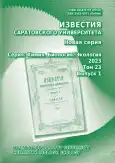Gold nanostars as a photoagent under the antimicrobial action of infrared (808 nm) laser radiation
- Authors: Simonenko A.V.1, Savelyev G.K.1, El-Khih A.N.1, Khanadeev V.A.2, Tuchina E.S.1
-
Affiliations:
- Saratov State University
- Institute of Biochemistry and Physiology of Plants and Microorganisms of the Russian Academy of Sciences
- Issue: Vol 23, No 1 (2023)
- Pages: 86-93
- Section: Articles
- URL: https://journals.rcsi.science/1816-9775/article/view/252005
- DOI: https://doi.org/10.18500/1816-9775-2023-23-1-86-93
- EDN: https://elibrary.ru/GVNYVU
- ID: 252005
Cite item
Full Text
Abstract
About the authors
Andrey V. Simonenko
Saratov State University
ORCID iD: 0000-0003-0730-4843
83, Astrakhanskaya str., Saratov, 410012, Russia
Grigoriy K. Savelyev
Saratov State University
ORCID iD: 0000-0002-9752-0541
83, Astrakhanskaya str., Saratov, 410012, Russia
Ayya Nidal El-Khih
Saratov State University
ORCID iD: 0000-0003-1149-3966
83, Astrakhanskaya str., Saratov, 410012, Russia
Vitaly A. Khanadeev
Institute of Biochemistry and Physiology of Plants and Microorganisms of the Russian Academy of Sciences
ORCID iD: 0000-0003-3404-5402
410049, Russia, Saratov, Entuziastov Avenue, 13
Elena S. Tuchina
Saratov State University83, Astrakhanskaya str., Saratov, 410012, Russia
References
- Feng Y., Liu L., Zhang J., Aslan H., Dong M. Photoactive antimicrobial nanomaterials // J. Mater. Chem. B. 2017. Vol. 5. P. 8631–8652. https://doi.org/10.1039/C7TB01860F
- Tao C. Antimicrobial activity and toxicity of gold nanoparticles: Research progress, challenges and prospects // Letters in Applied Microbiology. 2018. Vol. 67. P. 537–543. https://doi.org/10.1111/lam.13082
- Penders J., Stolzoff M., Hickey D. J., Andersson M., Webster T. J. Shape-dependent antibacterial effects of noncytotoxic gold nanoparticles // International Journal of Nanomedicine. 2017. Vol. 12. P. 2457–246. https://doi.org/10.2147/IJN.S124442
- Ray P., Lodha T., Biswas A., Sau T. K., Ramana V. Particle specifi c physical and chemical effects on antibacterial activities: A comparative study involving gold nanostars, nanorods and nanospheres // Colloids and Surfaces A: Physicochemical and Engineering Aspects. 2022. Vol. 634. Article 127915. https://doi.org/10.1016/j.colsurfa.2021.127915.
- Bagga P., Hussain Siddiqui H., Akhtar J., Mahmood T., Zahera M., Khan M. S. Gold nanoparticles conjugated levofl oxacin: For improved antibacterial activity over levofl oxacin alone // Current Drug Deliv. 2017. Vol. 14. P. 114–119. https://doi.org/10.2174/1567201814666170316113432.
- Hu W. C., Younis M. R., Zhou Y., Wang C., Xia X. H. In situ fabrication of ultrasmall gold nanoparticles/2D MOFs hybrid as nanozyme for antibacterial therapy // Small. 2020. Vol. 16. Article e2000553. https://doi.org/10.1002/smll.202000553.
- Franco D., Calabrese G., Guglielmino S. P. P., Conoci S. Metal-Based Nanoparticles: Antibacterial Mechanisms and Biomedical Application // Microorganisms. 2022. Vol. 10. P. 1778–1800. https://doi.org/10.3390/microorganisms100917788
- Khlebtsov B. N., Panfi lova E. V., Khanadeev V. A., Khlebtsov N. G. Improved size-tunable synthesis and SERS properties of Au nanostars // J. Nanopart. Res. 2014. Vol. 16. P. 2623. https://doi.org/10.1007/s11051-014-2623-8
- Frens G. Controlled nucleation for regulation of particle size in monodisperse gold suspensions // Nat. Phys. Sci. 1973. Vol. 241. P. 20–22. https://doi.org/10.1038/physci241020a0
- Gao J., Huang X., Liu H., Zan F., Ren J. Colloidal stability of gold nanoparticles modifi ed with thiol compounds: Bioconjugation and application in cancer cell imaging // Langmuir. 2012. Vol. 28. P. 4464–4471. https://doi.org/10.1021/la401956c
- Rahme K., Chen L., Hobbs R. G., Morris M. A., O’Driscolle C., Holmes J. D. PEGylated gold nanoparticles: polymer quantifi cation as a function of PEG lengths and nanoparticle dimensions // RSC Adv. 2013. Vol.3. P. 6085–6094. https://doi.org/10.1039/c3ra22739a
- Khlebtsov B., Tuchina E., Tuchin V., Khlebtsov N. Multifunctional Au nanoclusters for targeted bioimaging and enhanced photodynamic inactivation of Staphylococcus aureus // RSC Advances. 2015. Vol. 5. P. 61639–61649. https://doi.org/10.1039/c5ra11713e
- Ryan S. M., Mantovani G., Wang X., Haddleton D. M., Brayden D. J. Advances in PEGylation of important biotech molecules: Delivery aspects // Expert Opin. Drug Deliv. 2008. Vol. 5. P. 371–383. https://doi.org/10.1517/17425247.5.4.371
- Al-Ani A., Boden A., Al Kobaisi M., Pingle H., Wang P.-Y., Kingshott P. The infl uence of PEG-thiol derivatives on controlling cellular and bacterial interactions with gold surfaces // Applied Surface Science. 2018. Vol. 462. P. 980–990. https://doi.org/10.1016/j.apsusc.2018.08.136
- Zarkov S. V., Avetisyan Yu. A., Akchurin G. G., Akchurin G. G. jn., Bibikova O. A., Tuchin V. V., Yakunin A. N. Numerical modeling of plasmonic properties of gold nanostars to prove the threshold nature of their modifi cation under laser pulse // Optical Engineering. 2020. Vol. 59. P. 061628-34. https://doi.org/10.1117/1.oe.59.6.061628
Supplementary files









